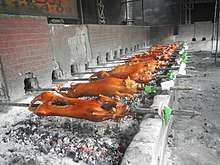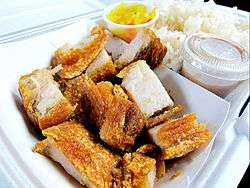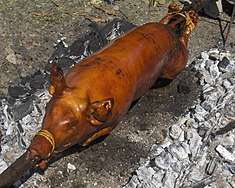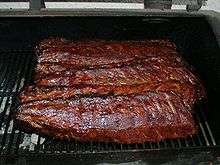Lechon
Lechón (Spanish pronunciation: [leˈt͡ʃon]; from leche “milk” + -ón) is a pork dish in several regions of the world, most specifically in Spain and former Spanish colonial possessions throughout the world. Lechón is a Spanish word referring to a roasted baby piglet which was still fed by suckling its mother’s milk (a suckling pig). Lechón is a popular food in Spain, Cuba, Puerto Rico, the Dominican Republic, and other Spanish-speaking nations in Latin America.[1] The dish features a whole roasted suckling pig cooked over charcoal. It has been described as a national dish of Cuba, Puerto Rico, and Spain.[2]
 Lechón being roasted in one of the lechon stores in La Loma, Quezon City, Philippines | |
| Course | Dish |
|---|---|
| Place of origin | Spain |
| Serving temperature | Hot |
| Main ingredients | Suckling Pig |
| Variations | Stuffing of lemongrass, onion, garlic (for Visayan variant) |

Additionally, it is popular in the Philippines and other Austronesian regions, whose pig-roasting traditions have native pre-colonial origins. Although it acquired the Spanish name[3] as a general term for “roasted pig“, in these regions it more often refers to adult roasted pigs, not lechones (milk suckling pigs). It is also sometimes considered as one of the unofficial national dishes of the Philippines,[4] with Cebu being asserted by American chef Anthony Bourdain as having the best pigs.[5]
Variants by country
Philippines
In most regions of the Philippines, lechón (also spelled litson or lichon) is prepared throughout the year for special occasions, festivals, and the holidays. Although it acquired the Spanish name, Philippine lechón has pre-Hispanic origins as pigs are one of the native domesticated animals of all Austronesian cultures and were carried throughout the Austronesian Expansion all the way to Polynesia.[3] It is a national dish of the Philippines.[4] There are two major types of preparing lechon the Philippines, the "Manila lechon" (or "Luzon lechon"), and the "Cebu lechon" (or "Visayas lechon").[6][7][7]
As the usage of the Spanish loanword evolved over the years in the languages of the Philippines, "lechón" has come to refer to roasted pig in general (including suckling pigs).[8] Roasted suckling pigs are now referred to in the Philippines as “lechón de leche” (which in Spanish would be a linguistic redundancy, though corresponding to the term cochinillo in Spain).

Visayan lechon is prepared stuffed with herbs which usually include scallions, bay leaves, black peppercorn, garlic, salt, and distinctively tanglad (lemongrass) and/or leaves from native Citrus trees or tamarind trees, among other spices. A variant among Hiligaynon people also stuffs the pig with the sour fruits of batuan or binukaw (Garcinia binucao). It is usually cooked over charcoal made from coconut husks. Since it is already flavored with spices, it is served with minimal dipping sauces, like salt and vinegar or silimansi (soy sauce, calamansi, and labuyo chili).[9][6][7][10]
Luzon lechon on the other hand, is typically not stuffed with herbs. When it is, it is usually just salt and pepper. Instead, the distinctiveness of Manila lechon comes from the liver-based sauce, known as the "lechon sauce". Lechon sauce is made from vinegar, brown sugar, salt, pepper, mashed liver (or liver spread), breadcrumbs, garlic and onion.[11] Manila lechon is also typically cooked over woodfire.[6]
Most lechon can either be cooked based on the two main versions, or mix techniques from both. Both variants also rub salt or spices unto the skin to make it crispier, as well as continually baste the lechon as it cooks. Sometimes carbonated drinks may also be used. They are cooked on a bamboo spit over charcoal for a few hours with constant (traditionally manual) turning. The pig is roasted on all sides for several hours until done. The process of cooking and basting usually results in making the pork skin crisp and is a distinctive feature of the dish.[8]
Leftover parts from the lechon, such as the head and feet, are usually cooked into another popular dish, lechon paksiw. Like lechon itself, lechon paksiw also differs based on whether it is prepared Luzon-style or Visayas-style, with the former using liver sauce as an essential ingredient, while the latter does not.[12][13] In some cases, these parts or stale lechon can be repurposed into another dish, such as Sisig.[14]
Puerto Rico
The dish has been described as a national dish of Puerto Rico.[15][lower-alpha 1] The name of the dish in Puerto Rico is lechon asado.[18] It is a traditional dish served at festivals and holidays.[19]
Footnotes
- Other dishes, have also been described as a national dish of Puerto Rico, such as the following dishes: asopao,[16] arroz con gandules.[17]
References
- Jonathan Deutsch; Megan J. Elias (15 April 2014). Barbecue: A Global History. Reaktion Books. p. 90. ISBN 978-1-78023-298-0.
- Maclay, Elise (1 October 2014). "Restaurant Review: Zafra Cuban Restaurant & Rum Bar". Connecticut Magazine. New Haven, Connecticut, United States. Retrieved 26 December 2019.
When it comes to “authentic” dishes like lechon asado (which Spain, Puerto Rico, the Philippines and Cuba all claim as their “national dish”), ingredients, recipes and methodology differ contentiously enough to start a war.
- Palanca, Clinton. "This is the Philippines' love story with pork". Smile Magazine. Cebu Pacific. Retrieved 1 October 2019.
- Vicky B. Bartlet (17 December 2011). "Palmonas: Make 'buko' juice as national drink". Business Mirror. Archived from the original on 10 January 2012. Retrieved 26 January 2012.
In his House Resolution 1887, Agham (Science) Party-list Rep. Angelo Palmones said the Philippines has already a number of national symbols, such as narra as national tree, sampaguita as national flower, mango as national fruit, milkfish as national fish and lechon (roast pig) as national dish.
Minahan, James B. (23 December 2009). The Complete Guide to National Symbols and Emblems [2 volumes]. ABC-CLIO. p. 152. ISBN 978-0-313-34497-8.
Geis, Darlene (1961). A Colorslide Tour of the Philippines: Island Democracy : Bright Garden of the Pacific. Columbia Record Club. p. 11.
Chan, Bernice (31 August 2017). "The secrets to great lechon - whole roasted suckling pig that's virtually a Filipino national dish". South China Morning Post. Hong Kong. Retrieved 14 December 2019.
Winn, Patrick (20 December 2012). "Philippines: New Year's Eve Lechon". Public Radio International. Minneapolis. Retrieved 14 December 2019.
Goodman, Vivian (26 December 2014). "Filipino community enjoys a taste of home in Akron". WKSU. Kent State University. Retrieved 14 December 2019.
Gardiner, Michael A. (11 December 2017). "Pork fat rules at Porky's Lechon". San Diego City Beat. United States. Retrieved 14 December 2019. - Lara Day (23 April 2009). "Pork Art". Time. Retrieved 8 April 2013.
Anthony Bourdain — whose love of all things porcine is famous — visited the Philippine island of Cebu with his show No Reservations and declared that he had found the best pig ever
- Faicol, Bea. "What's the Difference Between Luzon Lechon and Visayas Lechon?". Eat + Drink. Spot.ph. Retrieved 25 January 2019.
- Manahan, Millie (13 July 2017). "Manila or Cebu Lechon: A Staple Filipino Food for all Occasions". When In Manila. Retrieved 25 January 2019.
- Reynaldo G. Alejandro (8 December 2015). Food of the Philippines. Tuttle Publishing. p. 10. ISBN 978-1-4629-0545-4.
Customs and Culture of the Philippines. Tuttle Publishing. 15 June 1963. pp. 112–113. ISBN 978-1-4629-1302-2. - "Nothing quite like Negros Lechon – Bacolod". Now We Are Hungry. Retrieved 3 February 2019.
- Chan, Bernice. "The secrets to great lechon - whole roasted suckling pig that's virtually a Filipino national dish". South China Morning Post. Retrieved 25 January 2019.
- "Lechon Sauce". Kawaling Pinoy. Retrieved 25 January 2019.
- "The Lechon In Our Culture". EditorialToday A Guide to Business.
- "Lechon Paksiw (Bisaya Style)". Chedz Culinary Club. Retrieved 25 January 2019.
- Tiu, Cheryl (28 February 2015). "The Lechon Degustation: A Tribute to the Philippine Suckling Pig". Forbes. Retrieved 19 February 2020.
Uy, Amy A. (1 January 2013). "Easy holiday leftover makeovers". GMA News. Philippines. Retrieved 19 February 2020. - Squires, Kathleen (5 December 2014). "Where to Find the Best Roast Pork in Puerto Rico". Wall Street Journal. Retrieved 19 December 2019.
Ritschel, Chelsea (11 December 2019). "What Christmas Dinner Looks Like Around The World". Independent. United Kingdom. Retrieved 26 December 2019. - Himilce Novas (2007). Everything You Need to Know about Latino History. Plume. p. 164. ISBN 978-0-452-28889-8.
- Papadopoulos, Lena (16 March 2019). "From Mofongos to Maltas, Here's Everything You Should Eat and Drink in Puerto Rico". Fodors. Retrieved 26 December 2019.
- Gillan, Audrey (4 October 2018). "Around the Caribbean in 11 dishes". National Geographic. United Kingdom. Retrieved 26 December 2019.
"The 21 Best Trips For Foodies Around The World". Business Insider. India. 28 August 2015. Retrieved 26 December 2019.
"A 'Casual' Dinner in Puerto Rico". New York Times. 5 July 1978. Retrieved 26 December 2019. - Don Philpott (28 February 2003). Landmark Puerto Rico. Landmark Publishing Limited. p. 28. ISBN 978-1-901522-34-1.
External links
| Wikimedia Commons has media related to Lechon. |

